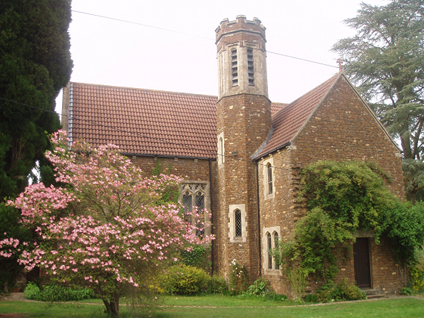
Some history...
In 1869 Sir Archibald MacDonald, the owner of a large estate to the north of Liphook, was received into the Church, and converted part of his house, Woolmer Lodge, into a chapel. This was the start of the Woolmer Mission.
Sir Archibald died in 1901 and was succeeded by his son Archibald John. In 1908 the chapel at Woolmer Lodge burnt down, and the MacDonald family moved away from the area. Woolmer Lodge became a Carmelite convent and the family sold a plot of about 60,000 square feet to the diocese for the building of a new church, school and cemetery. It is understood that Sir Archibald also paid for the building of the church (the school and cemetery were never realised). It was built to the designs of Canon A.J.C. Scoles and his partner (from 1903-20) Geoffrey Raymond (1881-1972).
Liphook became a parish in its own right in 1920. At that time the priest lived in a house further down the road; the present presbytery to the southeast of the church was built in 1962.
In 1965 a car park was laid out in front of the presbytery, to the south of the church. In 1969 a timber clad parish hall was built to the east of the church. The east end was underpinned and the church re-roofed in 1992.
The church is built in a Decorated and Perpendicular Gothic style, of local brownish-yellow sandstone laid in irregular courses, with limestone dressings, under a pantile roof. West porch, nave, chancel, south transept (sacristy), stair turret and belfry in the angle of the nave and transept.
The church is entered through an embattled west porch with a door on its south side, surmounted by a statue of Our Lady of the Immaculate Conception. Above this, a three-light, trefoil-headed Decorated west window, gable with narrow louvred lancet surmounted by a stone cross. The elevation is framed by stepped buttresses. The north elevation is plain, and consists of three two-light trefoil-headed and flat topped Perpendicular windows to the nave and two shorter lancets with cusped trefoils and two-centred arches to the chancel. Plain corbels support the gutter eaves. There is a buttress at the west end only; the northeast corner is treated plainly. Similar treatment for south side of the nave as far as the ‘transept’, which projects to the south, and houses the sacristy, with the organ chamber above. The west elevation of the transept has paired windows with Tudor arches in stone surrounds to the ground floor and a single window with similar detail above. The masonry is left rough at the corners of the transept, indicating an intention to build against this, possibly for the intended school. An octagonal stair turret about 40 feet in height is placed in the angle of the transept and nave, with narrow Tudor arches living light to the stair. Louvred belfry stage with dripmoulds over the openings, surmounted by an embattled parapet. The east elevation is plain.
The interior consists of a narrow single space under a wagon roof. The chancel is raised two steps up from the nave and the high altar a further three steps above that. The high altar is an elaborate stone and marble construction with pinnacles and a central Gothic canopy, and a carved frontal depicting the Last Supper. The east wall is plain, apart from a tall and ostensibly blocked arch, possibly reflecting (with the lack of external buttresses) an earlier intention for a larger building. There is an oak forward altar, introduced in 1993.
Two doors on the south side of the nave and sanctuary lead to the sacristy, and above this is a pair of open arches to the organ gallery. The pipe organ has been removed and replaced with an electronic organ.
There are three stained glass windows in the chancel, two on the north side (Blessed Virgin Mary and St John) and one on the south side (St Katharine). They date from 1911 and may be attributed on stylistic and circumstantial grounds to Lavers and Westlake, who worked elsewhere for the architect.
The floor is of tessellated marble screed, as elsewhere in Scoles’s churches. The nave pews are of pine, with IHS inscribed in most of inverted ogee-headed bench ends. The Stations and other statues are not of particular interest.
Now for the cache...
1) The coordinates are for a sign at the entrance to the church car park. Look for the phone number 01428 722 1A1
2) Now take a short walk around the outside of the church building (not the grounds) until you find the area where a few gravestones are sunk into the ground. Look for the gravestone of Bernard John Manning died 16.11.B3
3) Look for a plaque begining with the words "In memory of Mary Theresa..." How many letters in the next word = C
4) Look for the gravestone of Edmund W. McIlvenna died 1.7.201D
5) Look for the gravestone of Bert Benham born 31.1.19E9
Now you can calculate the position of the cache: N51° 0A.BCD W000° 48.DAE
**************************************
**************************************
For full information on how you can expand the Church Micro series by sadexploration please read the Place your own Church Micro page before you contact him at churchmicro@gmail.com.
See also the Church Micro Statistics and Home pages for further information about the series.
*************************************